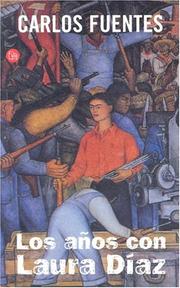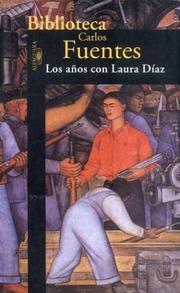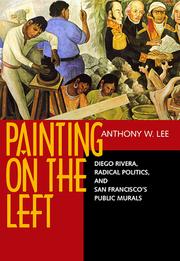| Listing 1 - 8 of 8 |
Sort by
|
Book
Abstract | Keywords | Export | Availability | Bookmark
 Loading...
Loading...Choose an application
- Reference Manager
- EndNote
- RefWorks (Direct export to RefWorks)

ISBN: 9789684112148 9684112149 Year: 2007 Publisher: México, D.F. Era
Abstract | Keywords | Export | Availability | Bookmark
 Loading...
Loading...Choose an application
- Reference Manager
- EndNote
- RefWorks (Direct export to RefWorks)
Book
ISBN: 1853320080 9781853320088 Year: 1987 Publisher: [Detroit] London Founders Society Detroit Institute of Arts ; Hayward Gallery in association with Norton
Abstract | Keywords | Export | Availability | Bookmark
 Loading...
Loading...Choose an application
- Reference Manager
- EndNote
- RefWorks (Direct export to RefWorks)
Painting, Mexican --- Rivera, Diego, --- Mexican paintings --- Rivera, Diego, 1886-1957 - Critical studies.

ISBN: 8466303456 9788466303453 Year: 2001 Volume: 108 Publisher: Madrid : Suma de Letras,
Abstract | Keywords | Export | Availability | Bookmark
 Loading...
Loading...Choose an application
- Reference Manager
- EndNote
- RefWorks (Direct export to RefWorks)
Rivera, Diego, --- Kahlo, Frida --- Mexico --- Social life and customs --- Kahlo, Frida, --- Kahlo, Frida, - 1907-1954 - Fiction --- Rivera, Diego, - 1886-1957 - Fiction --- Mexico - Social life and customs - 20th century - Fiction --- Kahlo, Frida, - 1907-1954 --- Rivera, Diego, - 1886-1957
Book
Year: 1993 Publisher: Gent : Museum voor Schone Kunsten Gent,
Abstract | Keywords | Export | Availability | Bookmark
 Loading...
Loading...Choose an application
- Reference Manager
- EndNote
- RefWorks (Direct export to RefWorks)
PEINTURE ET DECORATION MURALES --- PEINTURE MEXICAINE --- ALFARO SIQUEIROS (DAVID), 1896-1974 --- CLEMENTE OROZCO (JOSE), 1883-1949 --- RIVERA (DIEGO), 1886-1957 --- 20E SIECLE --- 20E SIECLE --- EXPOSITIONS --- EXPOSITIONS --- EXPOSITIONS --- PEINTURE ET DECORATION MURALES --- PEINTURE MEXICAINE --- ALFARO SIQUEIROS (DAVID), 1896-1974 --- CLEMENTE OROZCO (JOSE), 1883-1949 --- RIVERA (DIEGO), 1886-1957 --- 20E SIECLE --- EXPOSITIONS --- 20E SIECLE --- EXPOSITIONS --- EXPOSITIONS --- EXPOSITIONS --- EXPOSITIONS

ISBN: 8420430870 9788420430874 Year: 1999 Publisher: Madrid Alfaguara
Abstract | Keywords | Export | Availability | Bookmark
 Loading...
Loading...Choose an application
- Reference Manager
- EndNote
- RefWorks (Direct export to RefWorks)
Spanish-American literature --- Kahlo, Frida --- Rivera, Diego, --- Fiction. --- Rivera Barrientos, Diego María, --- Barrientos, Diego María Rivera, --- ריװערא, דיעגא, --- Kahlo de Rivera, Frida --- Rivera, Frida Kahlo de --- De Rivera, Frida Kahlo --- Khalo, Frida --- Kahlo y Calderón, Magdalena Carmen Frida --- Calderón, Magdalena Carmen Frida Kahlo y --- Calderón, Frida Kahlo --- Kahlo, Frieda --- Кало, Фрида --- קאלו, פרידה --- Kahlo, Frida - Fiction --- Rivera, Diego, - 1886-1957 - Fiction --- Rivera, Diego, - 1886-1957
Book
ISBN: 0826312454 Year: 1989 Publisher: Albuquerque : University of New Mexico press,
Abstract | Keywords | Export | Availability | Bookmark
 Loading...
Loading...Choose an application
- Reference Manager
- EndNote
- RefWorks (Direct export to RefWorks)
Mural painting and decoration, Mexican --- United States --- Mural painting and decoration --- 20th century --- Politics in art --- Rivera --- Criticism and interpretation --- Zapotlan, Jalisco --- Siqueiros, David Alfaro --- Wandmalerei --- Orozco, José Clemente <1883-1949> --- Rivera, Diego <1886-1957> --- Orozco, José Clemente --- Rivera, Diego --- Geschichte 1900-2000 --- USA --- USA. --- Wandmalerei.

ISBN: 0520923375 0585332584 9780520923379 9780585332581 0520219775 0520211332 Year: 1999 Publisher: Berkeley University of California Press
Abstract | Keywords | Export | Availability | Bookmark
 Loading...
Loading...Choose an application
- Reference Manager
- EndNote
- RefWorks (Direct export to RefWorks)
The boldly political mural projects of Diego Rivera and other leftist artists in San Francisco during the 1930s and early 1940s are the focus of Anthony W. Lee's fascinating book. Led by Rivera, these painters used murals as a vehicle to reject the economic and political status quo and to give visible form to labor and radical ideologies, including Communism.Several murals, and details of others, are reproduced here for the first time. Of special interest are works by Rivera that chart a progress from mural paintings commissioned for private spaces to those produced as a public act in a public space: Allegory of California, painted in 1930-31 at the Stock Exchange Lunch Club; Making a Fresco, Showing the Building of a City, done a few months later at the California School of Fine Arts; and Pan American Unity, painted in 1940 for the Golden Gate International Exposition.Labor itself became a focus of the new murals: Rivera painted a massive representation of a construction worker just as San Francisco's workers were themselves organizing; Victor Arnautoff, Bernard Zakheim, John Langley Howard , and Clifford Wight painted panels in Coit Tower that acknowledged the resolve of the dockworkers striking on the streets below. Radical in technique as well, these muralists used new compositional strategies of congestion, misdirection, and fragmentation, subverting the legible narratives and coherent allegories of traditional murals.Lee relates the development of wall painting to San Francisco's international expositions of 1915 and 1939, the new museums and art schools, corporate patronage, and the concerns of immigrants and ethnic groups. And he examines how mural painters struggled against those forces that threatened their practice: the growing acceptance of modernist easel painting, the vagaries of New Deal patronage, and a wartime nationalism hostile to radical politics.
Mural painting and decoration, American --- Street art --- Themes, motives. --- Rivera, Diego, --- Political and social views. --- Art, Street --- Art, Wall --- Wall art --- Art and society --- Mural painting and decoration --- Performance art --- Politics in art --- Graffiti --- American mural painting and decoration --- Rivera Barrientos, Diego María, --- Barrientos, Diego María Rivera, --- ריװערא, דיעגא, --- RIVERA (DIEGO), 1886-1957 --- MURAL PAINTING AND DECORATION --- STREET ART --- MODERN ART --- 20th CENTURY --- U.S --- U.S.
| Listing 1 - 8 of 8 |
Sort by
|

 Search
Search Feedback
Feedback About UniCat
About UniCat  Help
Help News
News